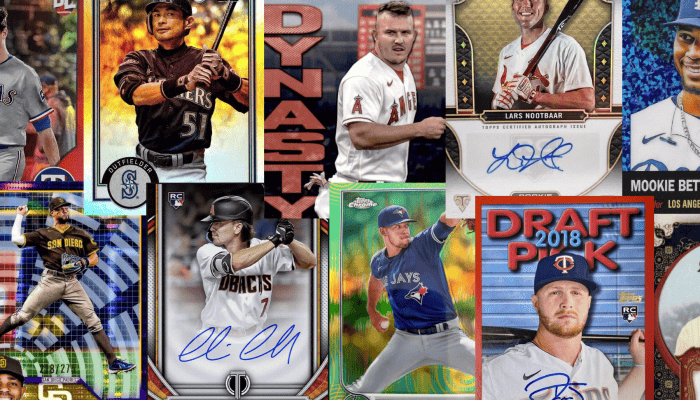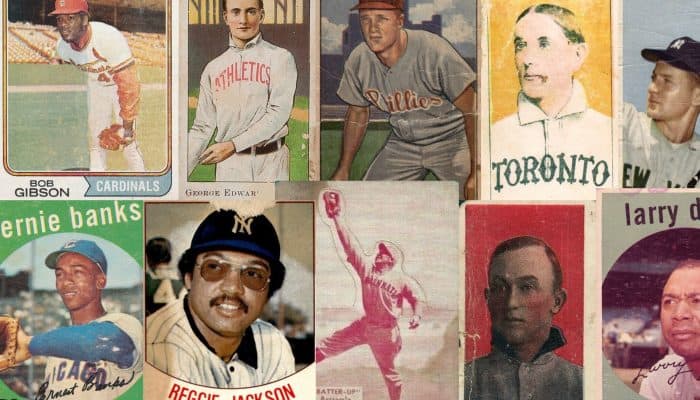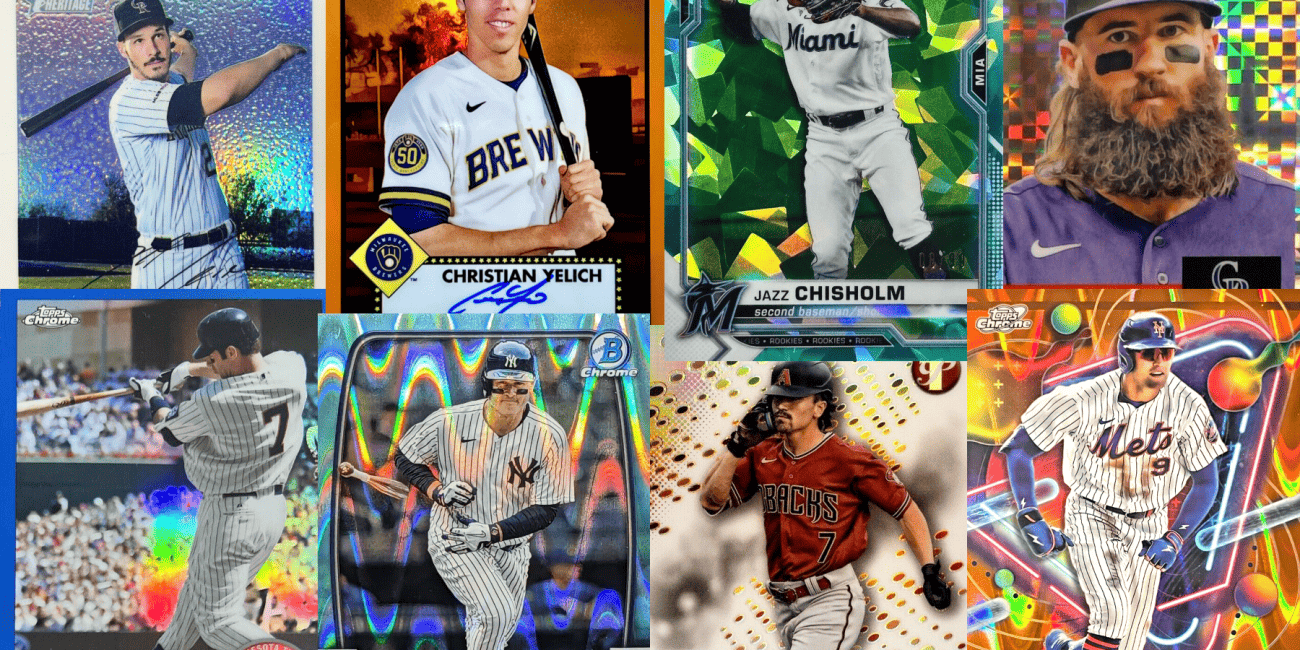
In the world of baseball cards, “refractors” refer to a specific type of trading card, typically associated with the Topps Chrome and Bowman Chrome sets (and their variations in other sports), that have a special shiny, reflective surface. These cards are known for their eye-catching and vibrant appearance. Refractors can come in various colors, which add to their appeal and rarity. These are divided into two categories:
- Base Refractors: These are the standard refractor cards, featuring a shiny, mirror-like finish. They are more common.
- Colored Refractors: These come in different colors, such as blue, green, gold, orange, red, and superfractor (usually 1/1) variations. The different colors often indicate the card’s rarity, with more limited colors being more valuable. Sometimes they’re serial numbered to make the rarity more obvious to collectors.
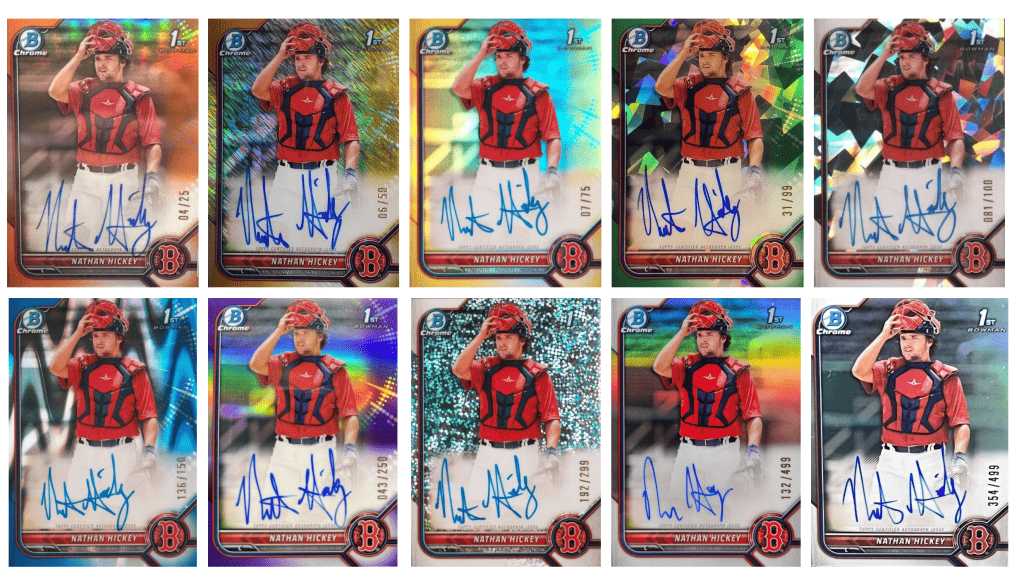
Refractor Printing Process
At first glance, a refractor card appears no different from its conventional counterparts. It features an image of a baseball player, statistics, and team logos. However, upon closer inspection, a refractor’s distinct characteristic emerges: a radiant surface that sets it apart from the rest. This shiny, mirror-like finish is achieved through a unique printing process:
Base Card Printing
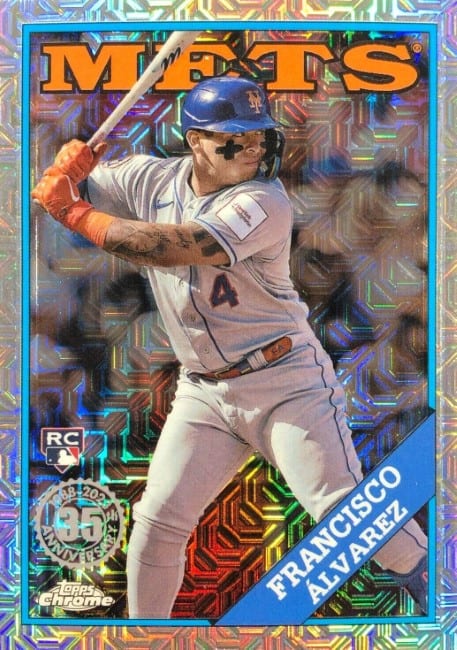
The process begins with the printing of the base card. The design of the card, including the player image, team logos, and other elements, is applied to the cardstock. The base card is typically printed with traditional methods like offset printing, digital printing, or other high-quality printing techniques.
Application of Coating
Once the base card is printed, a transparent, micro-thin layer of metallic coating is applied to the surface. This metallic coating is what creates the reflective quality of the refractor. The coating typically contains tiny, parallel lines or dots that help scatter light in a way that produces the shiny effect.
The application of the metallic coating can be done in a specific pattern. This pattern can vary depending on the desired effect. The lines or dots in the coating are often arranged in a grid or lattice-like pattern, and they are so fine that they are virtually imperceptible to the naked eye.
After the metallic coating is applied, the cards go through a curing and drying process to ensure that the coating adheres properly to the cardstock and maintains its reflective properties.
Cutting, Trimming & Finishing
All baseball cards – including refractors – are produced in large sheets before being cut, trimmed and quality-checked. These steps ensure that each card is uniform in size and appearance before they’re packaged for distribution. Refractors are no exception.
It’s important to note that the exact details of the printing process may vary depending on the card manufacturer and the specific set. Additionally, the colors and patterns used in the metallic coating can differ from card to card, leading to the variety of colored refractors in the hobby. The rarity of these colored refractors is often determined by the number of cards produced for each color variation, with some colors being more limited than others.
Like other inserts, refractors are distributed based on a probability system; for example, in 2023 Topps Finest, a green lava refractor is serial numbered to 99, and is distributed in 1 out of 66 hobby packs. However, these are averages and not guarantees. Spread across the 125-card set, that means 12,375 green lava cards were produced in total (99 for each player).
How Are Refractors Valued?
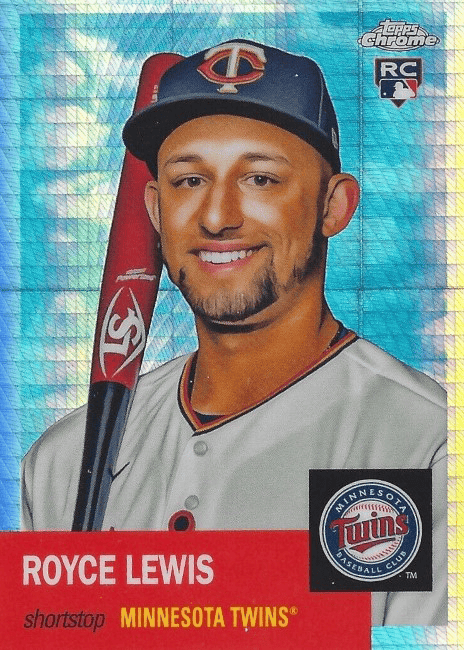
Several key factors influence the valuation of refractor baseball cards:
Player Significance
The most significant factor that drives the value of any card, including refractors, is the player featured on it. Cards of iconic players, All-Stars, or hot prospects are in high demand and, thus, more valuable. Superstar rookies, in particular, can command a premium, and there are over 20 refractor colors in recent editions of Bowman Prospects, so collectors have many different cards of their favorite player to chase.
Rarity
Refractors are already considered rare in comparison to standard cards due to their limited production. However, the rarity can be further divided based on the color of the refractor. In general, colored refractors tend to be rarer and more valuable than the base refractors. The exact print run for each color is often undisclosed, adding an element of mystery to the hobby. As a result, some collectors prefer serial-numbered refractors, so they know the exact rarity.
Sets and Subsets
Some refractor sets are more popular than others, which can have a direct impact on card values. The iconic status of sets like the 1993 Topps Finest Refractor set featuring Ken Griffey Jr. has helped maintain and increase the desirability of cards from these sets.
Some refractors may belong to special editions or subsets within a set. These limited-run cards, particularly those with unique designs or characteristics, often attract a premium.
The Most Expensive Refractor Baseball Cards
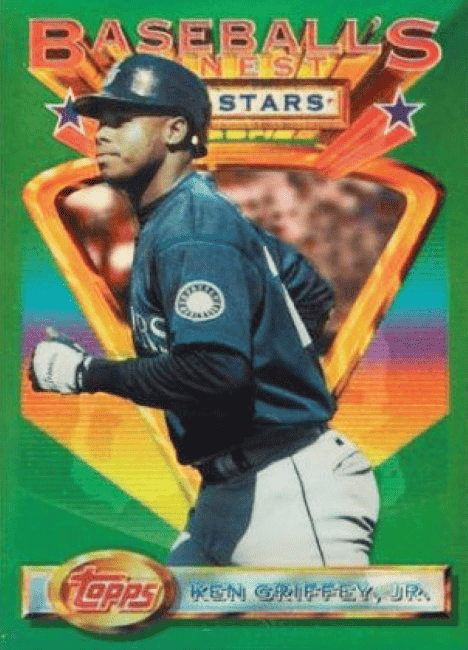
Determining the most expensive refractor baseball cards can be a dynamic task, as values can fluctuate based on player performance, market trends, and collector preferences. Nevertheless, some cards have consistently held their high value over time. Here are a few examples:
- 1993 Topps Finest Refractor Ken Griffey Jr.: As mentioned earlier, this card is often considered the pioneer of modern refractor cards. Ken Griffey Jr. was an iconic player, and his refractor rookie card remains highly sought after. PSA 10 versions of this card have commanded $10,000-$20,000 on the open market.
- 1996 Bowman’s Best Refractor Derek Jeter: A refractor featuring the legendary Derek Jeter is a collector’s dream. With Jeter’s induction into the Hall of Fame, the demand for his cards, particularly refractors, has surged.
- 1996 Select Certified Mirror Gold Derek Jeter: While not a traditional refractor, this card features a reflective, mirror-like gold surface. Given its scarcity and the player’s status, it consistently ranks among the most expensive refractor cards.
- 2009 Bowman Chrome Draft Mike Trout Gold Refractor: Mike Trout is widely regarded as one of the best players in recent baseball history, and his refractor cards are immensely popular. The Gold Refractor version from his 2009 Bowman Chrome Draft set is a coveted collector’s item.
- 2001 Bowman Chrome Albert Pujols Gold Refractor: Albert Pujols has had a storied career, and this Gold Refractor from his rookie year is highly valued among collectors.
It’s important to note that the values of refractor cards can vary significantly based on their condition and specific variations (e.g., the color of the refractor). Also, new high-value refractor cards may emerge over time as the sports card market evolves and players achieve new milestones.
Conclusion
Refractor baseball cards epitomize the allure of collecting in the world of sports cards. They’re rare, they’re special and they’re shiny – what’s not to like? As the baseball card market continues to evolve, refractors will undoubtedly remain a shining gem in the world of collecting.
